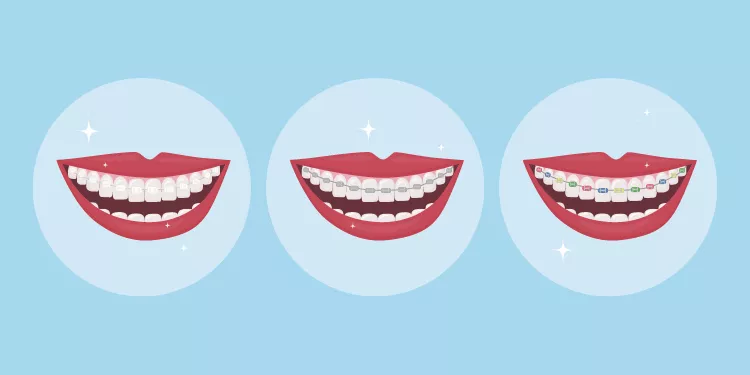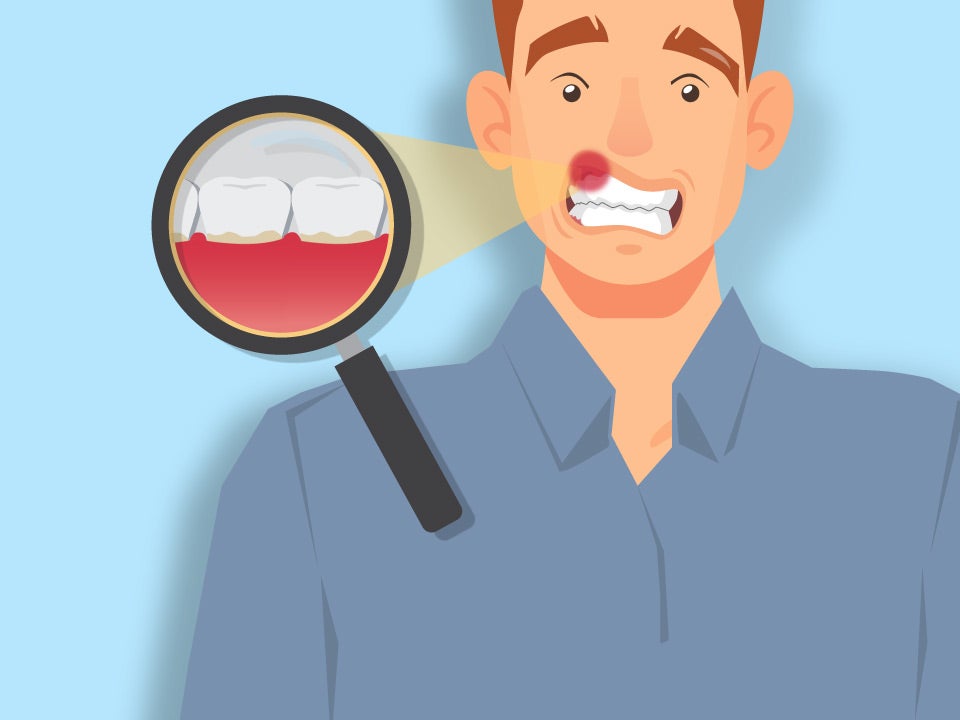Types of Braces
There are many types of braces that orthodontists may use to straighten teeth or correct tooth and jaw problems. Some options that may be available to you include traditional metal braces, ceramic braces, self-ligating braces, and lingual braces, as well as clear aligners such as Invisalign.
Traditional Metal Braces
Traditional metal braces are the most well-known option, and they’re probably what you imagine when you think of braces. They consist of stainless steel brackets that are bonded to the fronts of your teeth and a metal wire that’s threaded through the brackets. The wire is held in place with tiny elastics, known as ligatures.
Pros
- They’ve stood the test of time. Orthodontists have used metal braces to straighten teeth since the early 20th century. Traditional braces remain in use because their reliability and effectiveness are well established.
- They can correct complex issues. Compared to aligners, braces may give your orthodontist more control over the forces that reposition your teeth. If you have complex tooth issues, your orthodontist may recommend braces.
- They’re not removable. Traditional braces can only be removed by your dentist or orthodontist, so you can’t lose them or forget to wear them. This may appeal to people who prefer a hands-off method.
Cons
- They’re more noticeable than other options. With smaller brackets, today’s metal braces are less noticeable than the braces of the past. However, they’re still an obvious addition to your smile, unlike clear aligners.
- They may interfere with oral hygiene. Brushing and flossing may be more challenging with braces since you’ll need to brush around your brackets and thread floss under the wire.
- They may move teeth slower than aligners. A 2019 systematic review found that people with braces had longer treatment times than people with aligners.
Ceramic Braces
Pros
- They’re less noticeable than traditional braces. A major advantage of clear braces vs. metal is that the tooth-colored brackets blend in with your teeth. This provides a more natural appearance than metal braces.
- They have good biocompatibility. Ceramic brackets are biocompatible. This means they may be less likely to react with your oral tissues. This may make them a good choice for people who are sensitive to nickel or other metals.
- They don’t interfere with imaging tests. Your choice of metal or ceramic braces could affect imaging tests. Traditional metal braces may need to be removed before MRI scans of the head or neck, but ceramic braces with no metal components are MRI-safe.
Cons
- They may get stained. Both the ceramic brackets and the clear elastics used to hold the wires in position could become discolored. Your orthodontist may recommend avoiding foods and drinks that could leave stains, such as coffee or tomato sauce.
- They’re more fragile than traditional braces. When deciding between ceramic braces vs. metal braces, consider that ceramic brackets are much more vulnerable to chips and cracks than metal brackets. This means they may not be a good option for people who play contact sports.
Invisalign and Clear Aligners
Clear aligners are an alternative to traditional braces. They consist of a series of clear, custom-made trays that fit over the top of your teeth. Generally, you’ll wear each aligner for around two to three weeks. The aligners are worn 24/7, except when you’re eating, drinking, or cleaning your teeth. Invisalign is a well-known brand of clear aligner.
Pros
- They’re less noticeable than traditional braces. Clear aligners are nearly invisible, making them a discreet option for people who don’t want anyone to know they’re getting orthodontic treatment.
- They don’t interfere with oral hygiene. Compared to braces, it’s easier to keep your teeth clean with aligners. You can remove the aligners and brush and floss your teeth as normal.
- They don’t affect your diet. People with braces may be advised to avoid eating hard or sticky foods, such as gum or popcorn. Since aligners are removed at mealtimes, you’re free to eat your favorite foods.
Cons
- They may not be an option for everyone. Clear aligners can effectively straighten teeth, but they may not be as effective as braces for correcting some complex tooth or jaw alignment problems. Ask your orthodontist if you’re a good candidate for aligners.
- They require more discipline than fixed options. While you can take out clear aligners when it’s time to eat, drink, or clean your teeth, Invisalign recommends wearing aligners for 20 to 22 hours per day. You’ll need to keep track of your aligners and remember to wear them.
Self-Ligating Braces
Pros
- They may speed up some phases of orthodontic treatment. One study reported that people with self-ligating braces enjoyed faster results in their first three months of treatment compared to people with traditional braces.
- They may require less time in the dental chair. Self-ligating braces may require fewer orthodontic appointments than traditional braces. And since they eliminate elastic bands, your orthodontist may be able to adjust them more quickly.
Cons
- They may cost more than traditional braces. Self-ligating braces use specialized brackets, so they may cost slightly more than conventional braces. However, your treatment cost may vary, so ask your orthodontist for an estimate.
- They may be less effective for severe crowding. When the teeth are very crowded or rotated, it might not be possible to fully close the built-in clips that hold the wire in place. This could result in much slower tooth movement.
Lingual Braces
Pros
- They’re virtually invisible. Lingual braces are placed behind the teeth, so the brackets aren’t noticeable to others. They may be a good choice for people who want metal braces but don’t want anyone to know they’re wearing them.
- They don’t keep you from your hobbies. Unlike traditional braces, lingual braces may not interfere with your ability to play wind instruments, such as flutes or trumpets. They may also be safer for people who play contact sports and have a risk of getting hit in the face.
Cons
- They may cause temporary speech problems. Your tongue presses the back of your front teeth to make certain sounds, such as “s” or “z” sounds. Lingual braces could cause a temporary lisp until your tongue gets used to them. One study found that these speech difficulties could last for a month or more, so getting used to lingual braces could take some patience.
- They may be hard to clean. Since lingual braces are on the backsides of your teeth, it may take some extra effort to brush around the brackets and thread floss under the wires.
- They may cost more than traditional braces. Lingual braces are custom-made to fit the backs of your teeth, and orthodontists need specialized training to place them. For these reasons, they tend to be more expensive than other types of braces.
Find an Orthodontist Near You to Discuss Your Braces Options
With so many different types of braces to choose from, you’re sure to find one that meets your needs. If you want to get started and are asking where to find an orthodontist near me, use the Find a Dentist tool from Smile Generation to find a good orthodontist in your area. You can check out orthodontists’ bios and read reviews from patients like you. After choosing an orthodontist, it’s easy to book your consultation for braces online.
Find your trusted, local dentist today!
Sources
- American Association of Orthodontists. (n.d.). Aligners. https://www3.aaoinfo.org/treatments/aligners/
- British Orthodontic Society. (n.d.). Fixed appliances. https://www.bos.org.uk/Museum-and-Archive/Collection/Fixed-Appliances
- Dentistry IQ. (2013). Are braces better than Invisalign? https://www.dentistryiq.com/dentistry/orthodontics/article/16353676/are-braces-better-than-invisalign
- Zawawi, K. H. (2019). Comparison of orthodontic treatment outcomes with and without the use of orthodontic anchors. Saudi Medical Journal, 40(1), 57–62. https://www.ncbi.nlm.nih.gov/pmc/articles/PMC6343314/
- IntechOpen. (2018). Current concepts in orthodontics. https://www.intechopen.com/chapters/62469
- Wang, Y., & Jian, F. (2020). Effectiveness and efficiency of orthodontic treatment with Invisalign aligners compared with conventional fixed appliances: A retrospective study. Journal of Dental Research, 99(3), 269–275. https://www.ncbi.nlm.nih.gov/pmc/articles/PMC7072093/
- Colgate. (2023). Six options to get affordable braces for adults. https://www.colgate.com/en-us/oral-health/adult-orthodontics/six-options-to-get-affordable-braces-for-adults
- Colgate. (2023). What are lingual braces? https://www.colgate.com/en-us/oral-health/adult-orthodontics/what-are-lingual-braces
Smile Generation blog articles are reviewed by a licensed dental professional before publishing. However, we present this information for educational purposes only with the intent to promote readers’ understanding of oral health and oral healthcare treatment options and technology. We do not intend for our blog content to substitute for professional dental care and clinical advice, diagnosis, or treatment planning provided by a licensed dental professional. Smile Generation always recommends seeking the advice of a dentist, physician, or other licensed healthcare professional for a dental or medical condition or treatment.








